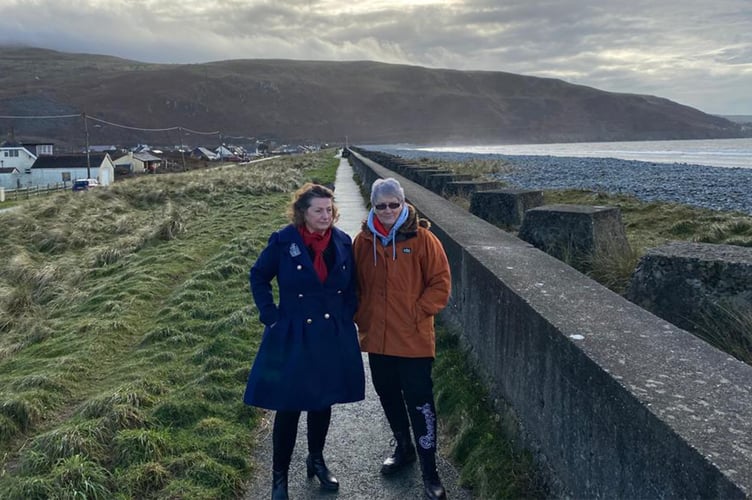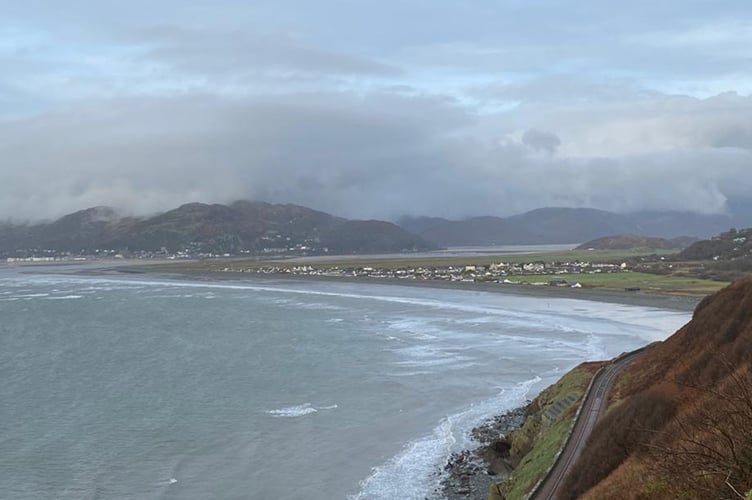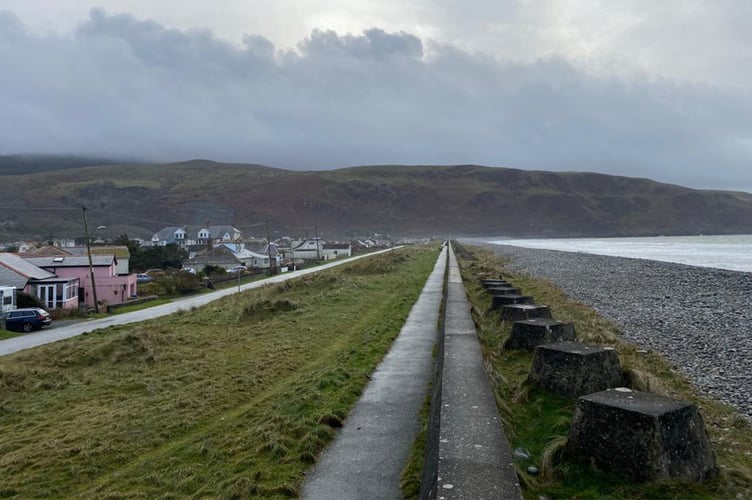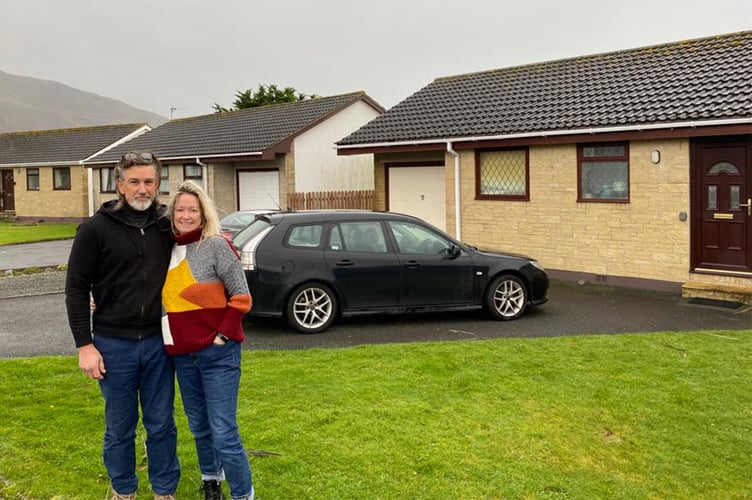"An elderly man in the village likened the situation to how it was during the war, waiting for the Germans to arrive and being told you have to be evacuated.”
That’s how Georgina Salt – who has lived in Fairbourne for 20 years – described to the Cambrian News the distress caused by Gwynedd Council’s 2013 decision to allow the village to be returned to the sea in little more three decades.
The authority now appears to be reconsidering the plan. But villagers say it has already done dreadful damage to the community.
Residents of the seaside village in Gwynedd vehemently oppose the idea that it should be ‘decommissioned’, depopulated and demolished by 2054 – and have always rejected their labelling as the UK’s first climate refugees.
In 2013 Gwynedd Council confirmed it would spend no more money defending Fairbourne against rising sea levels and flood encroachment – committing to so-called ‘managed realignment’ or measures which would soon prepare the village for ‘relocation’.
But now authorities including Gwynedd Council appear to be rowing back on the idea, with correspondence suggesting officials are ready to ditch previous commitments to ‘decommissioning’ - a strategy for which has never been clearly articulated - and the 2054 ‘doomsday’ deadline.
Alternative scientific modelling is also being reviewed by the council which questions the logic behind deserting the village – which has a population of about 700 people.
The Cambrian News spoke with residents on a grey and windy day in the village – despite their suspicions and, at times, resentment for journalists asking questions concerning their home.
They’re well accustomed now to the presence of the media since Gwynedd Council went public with its decision to eventually abandon Fairbourne.
“What we’re trying to avoid now is fake news, wrong news, inaccurate reporting,” resident and Arthog Community Council clerk Angela Thomas, whose family have lived in the village for 40 years, told the Cambrian News.
“No decision has been made to decommission Fairbourne – we want positive not negative writing!”

To illustrate this point, a newsletter written in November last year by Huw Williams, the former head of the Ymgynghoriaeth Gwynedd Consultancy (YGC) – an arm’s length firm performing environmental surveyance for the council – states: “There are no current plans to decommission the village.
“The Fairbourne Moving Forward Project Board (established to oversee future planning in the village) has been aware of the negative impact on the community as a consequence of the mention of ‘decommissioning’ Fairbourne in ‘2054’ by the press and other stakeholders.
“There have been significant revisions to climate change predictions since 2018 and it is now appropriate for the Fairbourne Moving Forward Project Board to review the current evidence and data going forward and this will inform future planning decisions.”
An email to Ms Thomas from Mr Williams last July also contains the line: “No public body - let alone Gwynedd Council - is intending to destroy Fairbourne.”
Nevertheless, council cabinet members, officers and consultants have been far from shy to use the euphemistic and bleak term ‘decommissioning’ and refer to it happening by 2054. Residents say the term has dictated the doom-laden media agenda for the last 10 years.
“We do have plenty of examples of these people referring to Fairbourne being decommissioned by 2054,” Ms Thomas said.
“But now they’re saying this was all false news and misquotes – and that the commitment to 2054 never went before a full council committee
“Their get out clause is saying they will now base decisions on the science as it develops – and that it was never a set date.
“But one of the things we find confusing is they had no plan whatsoever – although they talk about a masterplan - they never outlined where we were going to go or how they were going to house us.
“But it’s always been Gwynedd Council which has used the word decommissioning, talked about realignment or taking our houses overnight.
“Initially we were all going to have to pay for the demolition ourselves – now we’re not even sure there will be demolitions!”
She refers to plans the council considered to make residents pay £6,000 towards the demolition of their own homes.
“NRW has never used the word decommissioning when it comes to Fairbourne – they have always said it would be increasingly difficult to defend because of the money,” she added.
“But that’s the big picture. If the sea level rise gets so severe that Fairbourne is under threat, there are also stretches of coastline to the north and the south which will be in exactly the same predicament as us.
“So why say just Fairbourne will be decommissioned? It’s not Fairbourne alone – they’ve picked on us.
“We genuinely believe the council got a bit excited about being the first to decommission somewhere - because they could make a name for themselves, couldn’t they?”

The Shoreline Management Plan 2 was compiled by environmental regulator Natural Resources Wales (NRW) in conjunction with Dutch engineering consultancy Royal Haskoning. It was agreed in 2013 by Gwynedd Council along with other regional authorities. It commits the village to ‘managed realignment’ or ‘retreat’ - but does not use the term ‘decommission’ nor commit to a fixed year.
NRW officials have previously suggested that sea levels will rise by an average of 4.7mm every year. The Welsh Government predicts levels will rise on the nation’s coastline by about a metre over the next century. Modelling from charity Climate Central - based on Intergovernmental Panel on Climate Change data - estimates the roads nearest to the shoreline could be gone in less than two decades.
But ex-Aberystwyth University geologist Dr Graham Hall has modelled alternative outcomes for sea level rise over the next century and has criticised the non-peer reviewed reports used to justify Fairbourne’s desertion.
His wife, Margaret, recently summarised their arguments in an opinion piece they sent to various media.
It says it would be cheaper to defend Fairbourne than to decommission it and it criticises modelling as outdated and preparing for the ‘worst-case scenario’.
It also says the costs of reinforcing Fairbourne’s sea defences for the next century need only be around £10 million rather than the £115m projected by NRW.
She writes: “Has anyone paused to ask whether Fairbourne really is in any danger?
“The updated version of The West of Wales Shoreline Management Plan (SMP2) … covered almost the whole Welsh coastline. Detailed research on individual locations was not done.
“The computer model used to reach the conclusion that Fairbourne would be drowned by rising sea levels was crude and inaccurate and has been disproved by recent events.
“The model predicted that by 2018 a major storm would inundate Fairbourne.
“However, while Storm Clara in February 2020 and Storm Eunice in February 2022 caused extensive flooding and damage to property across North Wales, Fairbourne remained completely dry.
“Based on this new research and detailed computer modelling, a modest flood protection scheme costing under £10million pounds was proposed that would keep Fairbourne safe well into the future.
“Meanwhile, the cost quoted by Gwynedd Council for decommissioning is £27 million, which seems like an underestimate as it includes no money for compensating residents who will lose their homes.
“So why are Gwynedd Council determined to press ahead with their scheme?
“Which is more valuable: a thriving community with a school, shops, restaurants, a golf course and a miniature railway; or a few more acres of salt marsh?”
The £115m quoted by NRW is based on what the couple characterises as inaccurate projections over the next century and they argue the existing Ro Wen shingle spit is robust enough, with small alterations, to protect the village.
It is interesting that, after putting villagers and Dr Hall’s claims to Gwynedd Council press office, it refused to commit to the idea of decommissioning nor did it mention the 2054 target – seemingly reinforcing residents’ suspicions.
A Cyngor Gwynedd spokesperson said: “Following the adoption of the Shoreline Management Plan (SMP) for the west of Wales in 2013, a multi-agency project was established to address the complex issues that will eventually face the community of Fairbourne.
“It has drawn upon the expertise and knowledge of a range of organisations including Cyngor Gwynedd, Natural Resource Wales who are responsible for the actual sea defences, Arthog Community Council, the Emergency Services, Dŵr Cymru and the local community itself who are central to this work.
“More recently, Cyngor Gwynedd has commissioned a Peer Review to assess Dr Hall’s work.
“It would not be appropriate for us to comment further until the conclusions have been published.”
This will come as no consolation to Fairbourne residents who have seen the price of their properties slashed by 40-50 per cent and who have endured mental distress and, sometimes, physical trauma as a result of the council’s decision in 2013.
Arthog Community Council chairperson and councillor, Ms Salt said: “The decision taken by Gwynedd Council was extremely damaging to the village and its community.
“It was a huge mistake to pinpoint a Fairbourne rather than taking a broad-brush stroke to the geography.
“It has done damage to the mental, financial and sometimes the physical health of people here.
“There’s been a huge loss of legacy. The value of the properties that people thought would take care of them in their old age or pass on to children etc.
“Some of the elderly get very emotional and fearful about it – they don’t know what they’re going to do next.
“Gwynedd Council knows what will happen physically, but they have in no shape or form said what will happen to the people.
“But we are now seeing a softening in the stances from authorities.”

NRW has also committed to meeting with Gwynedd Council and the Welsh Government to discuss peer reviewing the work of Dr Hall.
A spokesperson said: “We continue to maintain flood defences in Fairbourne to protect the village during adverse weather situations and minimise flood risk. This includes monitoring inspections during and after weather events and ongoing repair and maintenance work.
“While Welsh Government funding is available, and it is sustainable to do so, we will continue to monitor and maintain the flood defences to protect the community of Fairbourne.
“Defending Fairbourne is a challenge - we are working against nature to try to reduce the risks at a time when the climate is changing and sea levels are rising.
“This is in line with Shoreline Management Plan policies based on existing evidence of sea level rise.
“NRW has a strategic oversight role in terms of flood risk in Wales and permissive powers to construct and maintain defences, NRW therefore has no role in deciding the future of communities.
“We continue to raise awareness about the impact flooding can have on communities, the ongoing Climate Emergency and work with partners to develop long-term plans for vulnerable locations such as Fairbourne.”
The Cambrian News sat down with residents, including Ms Salt and Ms Thomas, who bemoaned the ‘destructive power of the media.’
Ms Salt said: “Media coverage can be very, very destructive and a certain portion of the population gets very stressed by it when a storm is coming in - stacking their sand bags and things.
“But after all these big storms in the last few years, we’ve had nothing – we had some shingle being scattered and that was it. Barmouth had walls knocked down!
“People find that surprising because of all the media coverage.
“We’ve had two incidences of significant flooding in the last century. We don’t get floods.
“A lot of the media takes its information from existing misleading reports - so it’s Chinese whispers.”
The Cambrian News also spoke with residents – old and new – about life in the village, post-Gwynedd Council’s fateful decision.
Great-grandmother Joyce Currie, aged 97, has been coming to Fairbourne ever since she was born in 1925 and has had a home there ever since. She moved back permanently 27 years ago.
“This is what I call my real home environment – I’m most at home here,” she said.
“People in Fairbourne have suffered. I’ve got two or three friends who haven’t been able to sell their homes and are in a position where they’re stuck with them.
“Where are they going to put us? It is unfair because all across Wales there are floods. Barmouth has it far worse than we do.”
Astonishingly, all the residents the Cambrian News spoke with said their homes have never been flooded – and that any flooding of the surrounding area comes from the hillside rather than the sea.
Ms Thomas pointed out the irony that major flooding in the Dyfi Estuary saw the A487 closed off in Machynlleth while Fairbourne was completely unscathed despite heavy rainfall last week.
It has long been suggested by residents that there are other areas of coastline in much greater, or at least similar, danger to sea level rise and coastal flooding – yet it is only Fairbourne that has been condemned to being ‘decommissioned.’
The Cambrian News recently investigated claims that Borth village in Ceredigion is also under threat due to sea level rises over the next several decades, with worst-case scenario modelling showing that flooding could make it unlivable far sooner than 2054.
The Welsh Government said: “We are working with communities facing rising sea levels and extreme weather, both of which we can expect to increase as a result of climate change. In some circumstances, difficult decisions will need to be considered in order to safeguard people and property.”

Gary Malloy and his partner Sharon moved to Fairbourne from Yorkshire barely a fortnight ago and told the Cambrian News they weren’t at all put off by the ‘doomsday narrative’ surrounding the place. Only cash buyers are permitted to purchase homes in Fairbourne since the council’s decision.
“As soon as we came past the road with the George III Hotel and saw the beach we were sold,” he said.
“We knew it was in a flood risk zone and we had heard that the council was going to stop defending the village from 2054.
“But I’ll be 83 by then so do I really give a monkey’s? It’s not automatically like Fairbourne’s gone in 2054 anyway.
“I’m not going to govern my life because of what someone says is going to happen in 30 years’ time.
“It’s paradise for us.
“From talking to people, they say it’s never been flooded – and tell us not to worry about it.”
A shop owner who preferred not to be named told us: “We just think it’s rubbish. The flooding is a lot worse at Aberystwyth and Barmouth so we just ignore it really.
“It devalued houses and people couldn’t get mortgages and things.
“But it’s scaremongering and it frightens people off. It’s a lovely place here.”
But for the last decade, villagers have seen their world turned upside down and many were resentful at how the saga had been handled.
Ms Thomas explained that once her father had died, she tried to sell his home – part of his legacy to her.
She says the four-bedroom home ought to have been valued at around £260,000 – but it sold for just £170,000. She says this explains why so many became spooked by the threat of decommissioning and left Fairbourne.
She and Ms Salt criticised a documentary by S4C which aired on BBC Wales last Tuesday entitled Fairbourne: The Sea at the Door.
They say it painted a ‘nostalgic’ and mistaken picture of a village soon to be lost.
Residents told us they are eagerly awaiting clarification from Gwynedd Council about whether their lives can continue in the village beyond 2054 - as well as an explanation for the trauma and distress of the last 10 years.
But Fairbourne’s newest resident, Mr Molloy, seemed to epitomise the views of all the village’s inhabitants: “I’m going to live here until I get dragged out kicking and screaming or until I pass away.”



